Reaching for ‘Realistic,’ the Minds Behind ‘The Crime Is Mine’ Instead Produce a Patently False Film
Director François Ozon’s picture has the trappings of a screwball comedy and the patina of an MGM musical, albeit without the crispness of the former or the integrity of the latter.

French director François Ozon tasked cinematographer Manu Dacosse to watch a specific set of films before they started work on “The Crime Is Mine.” These included pictures by Sacha Guitry, a multi-faceted talent referred to by the Criterion Collection as the “Gallic Noël Coward,” and Ernst Lubitsch, the auteur behind sparkling entertainments like “Trouble in Paradise” and “Design for Living,” both from 1932.
“Our challenge,” Mr. Dacosse writes, “was to create realistic cinematography that was true to the period without attempting to reproduce what we were seeing in those 1930s films.” Artistic ambitions rarely achieve fruition without occasioning a few curve balls, and what’s striking about “This Crime Is Mine” is how far removed it is from the realistic. The production design, the acting, the tempo, and, yes, the cinematography are patently false. This is a movie that looks like a movie.
And it’s not just any kind of movie: “The Crime Is Mine” has the trappings of a screwball comedy and the patina of an MGM musical, albeit without the crispness of the former or the integrity of the latter. Messrs. Ozen and Dacosse, along with their cinematic cohorts, haven’t taken inspiration from precedent so much as imbued it with a halo of nostalgia. The soft focus, the warm color palette, and dialogue that comes replete with a nod and a wink: What a cozy world this is.
Which is to say “The Crime is Mine” will be catnip for those who like their camp served at room temperature. The film is based on “Mon Crime,” a 1934 stage play by Georges Berr and Louis Verneuil. It’s already been adapted two times over on film. “True Confession” (1937) starred Carole Lombard and a mustachioed Fred MacMurray; “Cross My Heart” (1946) featured Betty Hutton as Peggy Harper, a chorus girl accused of murder.

This time around it’s Madeline Verdier (Nadia Tereszkiewicz), who stands trial for the murder of theatrical producer Montferrand (Jean-Christophe Bouvet in full gargoyle mode). Monsieur Montferrand was happy to cast Madeline in his new play, but only if she settled for a supporting role and, more important, settled on his casting couch for a couple of afternoons each week. When we first meet Madeline, we see her storming out of the producer’s palatial estate.
She makes it home just in time to run into her roommate, Pauline Mauléon (Rebecca Marder), having it out with the landlord, Pistole (Franck de la Personne). The rent hasn’t been paid in months. Given that the financial largesse stemming from Madeline being cast in a play didn’t pan out — well, what’s a pair of bi-curious young women in an economically depressed Paris to do?
Yes, I said “bi-curious.” Mr. Ozon, who “freely adapted” the source material, instills a “wily feminist edge” into the proceedings for fear, I suppose, that contemporary audiences don’t have the intellectual wherewithal to intuit the story’s already existing subtexts about power, politics, and gender. Sometimes, strong-arming a work of art into being relevant only ensures that its sell-by date is coming due.
Be that as it may, “The Crime Is Mine” hews to a normative trajectory when Madeline stands trial for the murder of Montferrand — who was found dead shortly after suffering Madeline’s rebuffs. Did she kill the old man? Not according to Odette Chaumette (Isabelle Huppert), a legend of the silent screen eager for some notice, any kind of notice, please notice me now. Mademoiselle Chaumette, with that expansive mop of red hair and extravagant costumery, is an El Niño-like combination of Miss Havisham, Norma Desmond, and Cruella De Vil.
Ms. Huppert isn’t the only old pro willing to engage in some shtick for Mr. Ozon: among the other players are veterans of stage and screen like Dany Boon, André Dussollier, Régis Laspalès, Olivier Broche, and Fabrice Luchini. Although they all seem to be having fun, none of them are as ferocious as Ms. Huppert. Did she intuit that this was a screenplay in need of some spark?
Mr. Ozen and his cinematic affectations are an acquired taste. Sampling “The Crime Is Mine” won’t cause undue distress to the uninitiated, but its strenuous need to be charmante is best left to the more charitable amongst us. Better to stick with Mssrs. Guitry and Lubitsch for this kind of thing: “Design for Living” is an ideal place to start.

